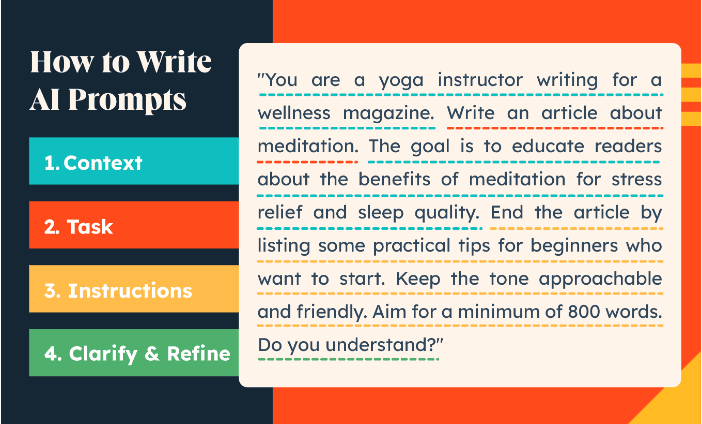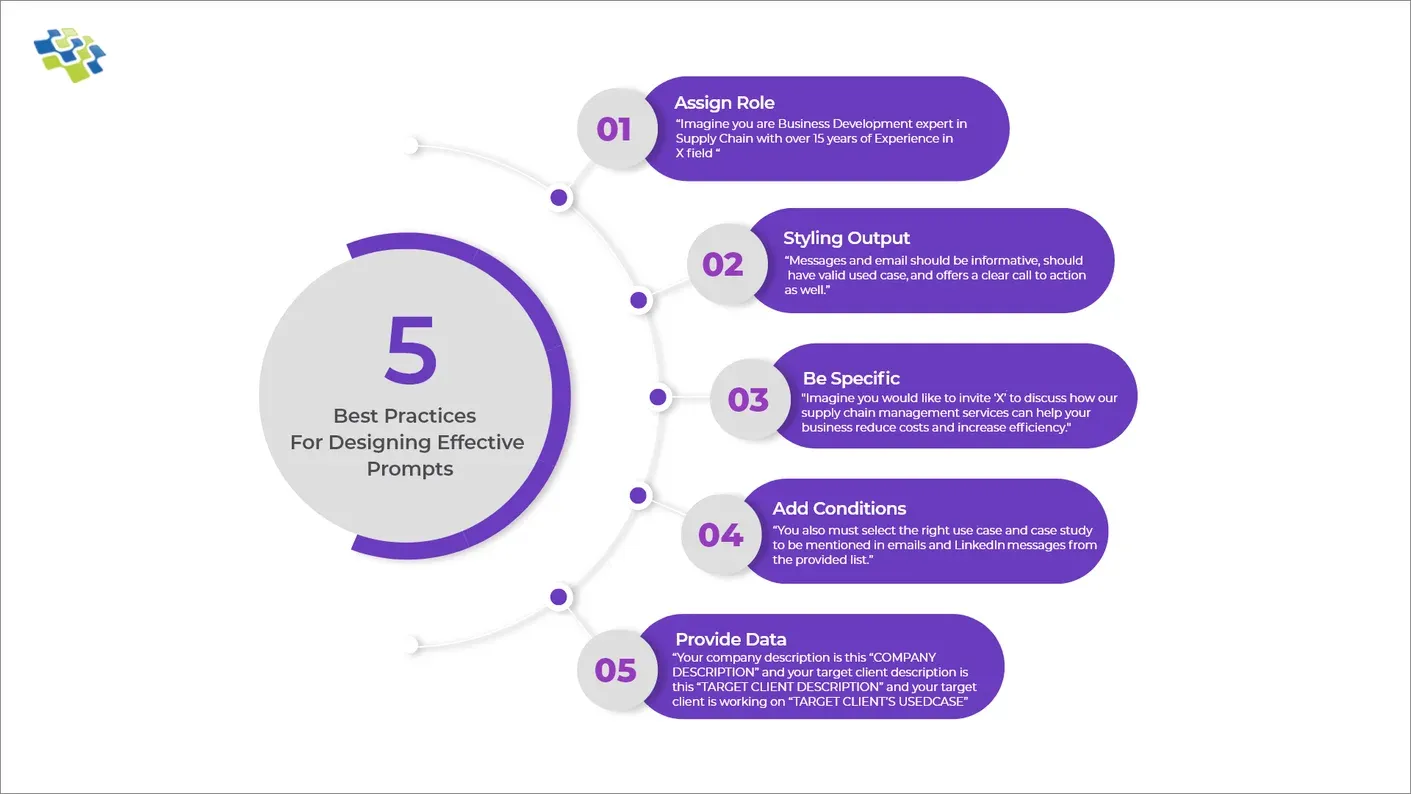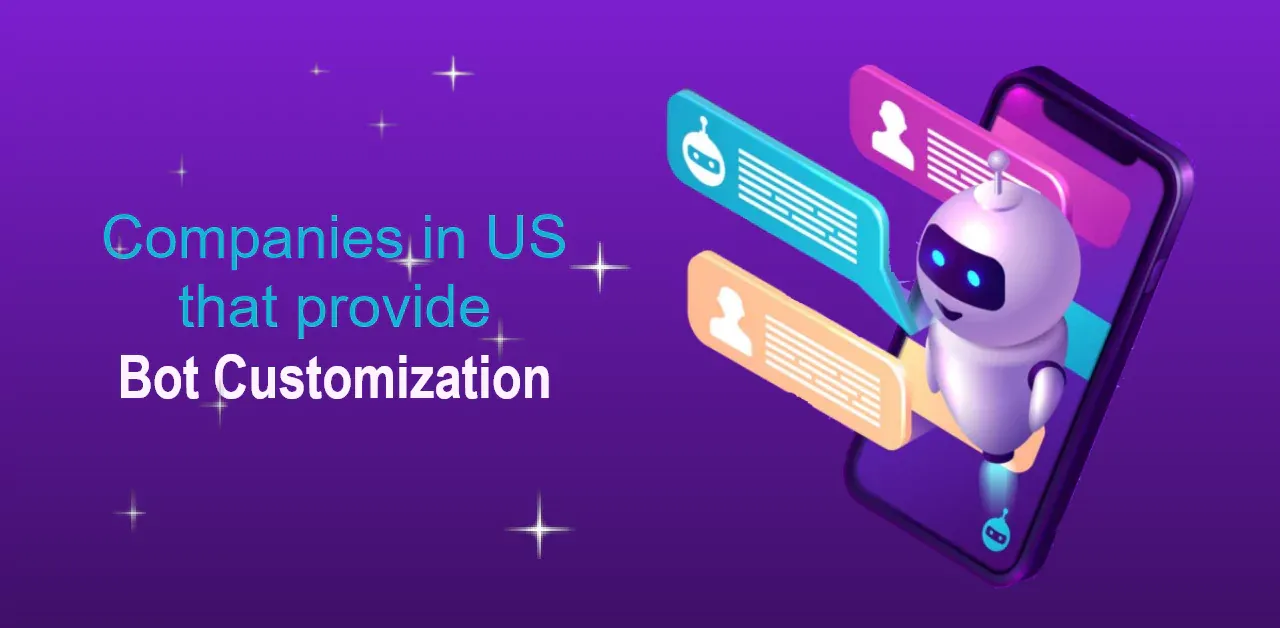Ever ask a question from your AI tools, only to get a nonsensical answer?
Or give instructions, but see the results go haywire?
You ask a simple question, and it dishes out an answer that makes zero sense.
If you've been there, you know how maddening it can be.
But hold up, because Prompt Engineering is about to solve all these problems for you.
This guide isn't just a bunch of tips—it's the ultimate conversation starter for you and your AI.
We're talking clear communication, spot-on answers, and interactions that feel less robot and more rhythm.
At the end of this guide, you’ll learn about:
-Talking to your AI like it actually understands you. ️
-Getting the answers you really need.
-Transforming your AI interactions from frustrating to fantastic!
Let’s dive in!
Understanding the Basics of Prompts
Prompts in engineering provide context to explore designs and solutions. An effective prompt concisely outlines the problem or project parameters in plain language.
It gives just enough detail for possible approaches to be brainstormed without limiting creativity. Open prompts encourage many responses by asking broad questions, while closed prompts narrow the discussion with specific criteria to consider.
Prompts should include any relevant technical specifications, environmental factors, and constraints to inform responses.
They set the stage for evaluating and improving upon ideas to advance engineering innovations of tomorrow. Clear prompts are key to sparking insightful discussions that further our understanding.
Types of Prompts
Depending on the desired outcome and context of their AI applications, developers can utilize several types of prompts.
Here are three common types:
- Instructional Prompts
Instructional prompts provide explicit guidance to the AI model on generating responses. These prompts are particularly useful when developers want to ensure specific behaviors, answer formats, or stylistic choices in the generated output.
- Contextual Prompts
Contextual prompts provide relevant information or context for AI models to generate more informed responses. By setting the context through prompts, developers enable AI models to understand the nuances of the input query and tailor their responses accordingly.
- Clarifying Prompts
Clarifying prompts seek additional information or clarification from the user when the AI model encounters ambiguous queries. By incorporating clarifying prompts, developers enable AI models to gather more specific details and provide more accurate responses.
After understanding the basics of AI prompt engineering, we will cover its role in improving AI model outputs.
The Role of Prompt Engineering in Improving AI Model Outputs

Prompt engineering is a powerful technique that can significantly enhance AI model outputs. In this section, we will explore how prompt engineering improves AI model performance.
Enhancing Model Performance with Well-crafted Prompts
Well-crafted prompts can greatly influence the performance of AI models. By providing clear instructions and relevant context, developers can guide AI models to generate more accurate, concise, and contextually appropriate responses.
Careful, prompt engineering improves the overall quality and reliability of AI-generated outputs.
Fine-tuning Prompts for Specific Use Cases
Prompt engineering allows developers to fine-tune prompts for specific use cases. Different applications may require tailored prompts to ensure optimal performance. By refining prompts based on specific requirements and user needs, developers can fine-tune AI models to deliver superior output.
Suggested Reading:
How to Engineer Prompts that Work?

To create effective prompts, it's crucial to understand the task you're attempting to accomplish and the nature of your data. Familiarize yourself with your dataset, analyze its structure, and determine the underlying patterns. Let's consider a sentiment analysis task - your goal is to classify the sentiment of customer feedback as positive, negative, or neutral. An example prompt for this scenario would be, "Determine the sentiment of this customer review: {review}."
Focus on Contextual Clarity
A well-structured prompt offers context to the model, ensuring relevancy to your requirements. Avoid overly vague or ambiguous prompts that may mislead the model.
For instance, if you want your model to summarize a given article, instead of writing "Summarize this:", provide more context like "Provide a concise summary of the following article in 3-4 sentences: {article}".
Formulate Open-ended Prompts
Incorporating open-ended prompts can encourage a broader range of responses, particularly suitable for creative or knowledge-intensive tasks.
Suppose you want to generate hypothetical consequences of reducing carbon emissions. An open-ended prompt could be, "List four possible outcomes if carbon emissions are reduced by 50% within the next ten years." This approach invites diverse and insightful outputs instead of limiting responses.
Experiment and Iterate
Prompt engineering often involves trial and error. Engage in a cycle of experimentation, evaluation, and iteration to enhance your prompts.
Let's assume you're generating questions from a paragraph of text. Begin with a simple prompt like "Generate three questions from the following paragraph: {paragraph}". If the results are inadequate, you may refine the prompt to be more specific, such as "Generate three relevant multiple-choice questions using the information from the paragraph: {paragraph}".
Leverage Pre-training Data
Machine learning models rely on their pre-training data to generate responses. Align your prompts with the model's knowledge base to achieve improved outcomes.
If you're working with a language model pretrained on scientific articles, a prompt like "Provide a brief explanation of the role of mitochondria in cellular respiration" should yield better results compared to a casual language prompt like "Explain mitochondria and stuff they do".
Next, we will cover best practices for prompt engineering.
Suggested Reading:
Best Practices for Prompt Engineering

Now that we have covered the basics of AI prompt engineering, let's look into some best practices to help you master the art of designing effective prompts for AI models.
Conducting Thorough Research and Analysis
Before diving into prompt engineering, it is crucial to conduct thorough research and analysis.
This will provide a solid foundation for crafting prompts that align with the target audience and goals of your AI application.
- Identifying the Target Audience and Goal
Understand your target audience and the goals you aim to achieve with your AI model. Tailor your prompts to match your audience's expectations and needs. Consider their language preferences, information requirements, and the overall tone of the interaction.
- Exploring Existing Prompts and Examples
Study existing prompts and examples in your domain to gain insights and inspiration. Analyze successful prompts used by others in similar applications. This research can help you understand what works well and what to avoid, enabling you to design prompts that resonate with your intended audience.
Designing Clear and Concise Prompts
The clarity and conciseness of your prompts play a crucial role in guiding AI models to generate accurate and relevant responses.
Here are some key considerations when designing prompts.
- Choosing Appropriate Wording and Tone
Craft prompts using language and tone that will resonate with your target audience. Use conversational, warm, and friendly language to create an engaging and comfortable user experience. Adjust the tone depending on the prompt's purpose, whether instructional, contextual, or clarifying.
- Defining Desired Outputs and Constraints
Clearly define the desired outputs and any constraints for the AI model. This helps guide the prompt generation process and ensures the model generates responses that align with your objectives. Consider specific formatting requirements, relevant information, or any constraints related to resource limitations or ethical considerations.
Experimentation and Iteration in Prompt Engineering
AI Prompt engineering is an iterative process that requires experimentation and constant refinement.
Here are some strategies to optimize your prompts.
- Implementing A/B Testing for Different Prompts
To identify the most effective prompts, implement A/B testing. Create multiple versions of prompts and compare their performance to determine which prompt design leads to better outputs. Iteratively refine and test various prompts to optimize the performance of your AI model.
- Analyzing and Refining Prompts Based on Results
Analyze the results of your A/B testing and user feedback to refine and improve your prompts. Identify patterns and gather insights to understand what prompts resonate best with your audience and produce the desired outputs. Continuously iterate on your prompts to enhance the performance and user experience of your AI model.
Next, we will see how to use AI prompt engineering for different AI applications.
Suggested Reading:
Hiring Prompt Engineers- easy way to AI automated efficiency
Leveraging Prompt Engineering for Different AI Applications
Prompt engineering is a versatile technique that can be applied to various AI applications. Let's explore how prompt engineering can be leveraged in different domains.
Natural Language Processing (NLP)
In NLP applications, AI prompt engineering is vital in guiding AI models to generate accurate and contextually relevant responses.
By carefully designing prompts, developers can train models to understand user queries and provide meaningful outputs.
With effective, prompt engineering, NLP models can excel in tasks like sentiment analysis, text classification, and language translation.
Chatbots and Conversational AI
Prompt engineering is essential for creating engaging and natural conversations with chatbots and conversational AI systems.
Well-crafted prompts enable chatbots to understand user queries, maintain context, and generate appropriate responses.
Designing prompts that mimic human conversation can enhance the user experience and foster better interactions.
And speaking of chatbots, get custom-made conversational AI solutions from BotPenguin by hiring ChatGPT Developers in 3 days. Our developers pack 5+ Years of experience designing prompts, embeddings, plugins, training, chatbots, or any custom application for efficient NLP and language model use.
- Whitelabel ChatGPT
- Hire ChatGPT Developers
- Custom ChatGPT Plugins
- Hire Chatbot Developers
- Custom Chatbot Development
- ChatGPT Clone
- ChatGPT Consultant
Content Generation
In applications involving content generation, prompt engineering helps shape the output of AI models. By providing clear instructions and defining desired constraints, developers can guide models to generate well-structured and coherent content.
Whether it's generating blog posts, product descriptions, or creative writing, prompt engineering ensures that AI models produce high-quality outputs.
Question Answering Systems
Prompt engineering is crucial for developing question-answering systems that provide accurate and informative answers. Through well-designed prompts, developers can guide AI models to understand the intent behind the question and generate relevant and precise responses.
By incorporating prompts that prompt for clarification when necessary, question-answering systems can improve their accuracy and user satisfaction.
Recommendation Engines
Prompt engineering is an effective approach for recommendation engines that provide personalized suggestions.
Developers can guide AI models to generate tailored recommendations by designing prompts that gather user preferences, demographics, or past behavior.
Well-crafted prompts enable recommendation engines to understand user preferences and deliver relevant and valuable suggestions.
Next, we will see the challenges and considerations in Prompt engineering.
Suggested Reading:
Make State-of-the-art AI Tools with Expert Prompt Engineers
Challenges and Considerations in Prompt Engineering
While prompt engineering offers many benefits, there are some challenges and considerations to consider.
Bias and Fairness in Prompts
Developers must be mindful of bias and fairness when designing prompts. Biased or discriminatory language in prompts can lead to biased outputs from AI models.
It is essential to craft prompts carefully and avoid reinforcing stereotypes or biases. To ensure fairness in AI-generated content, prompts should be regularly reviewed and audited.
Ethical Considerations in Prompt Design
Prompt engineering raises ethical considerations, especially when generating content or interacting with users.
Design prompts that prioritize user privacy, safety, and consent. Clearly communicate the capabilities and limitations of AI systems to users to avoid potential misuse or misunderstanding.
Monitoring and Addressing Potential Pitfalls
Prompt engineering requires ongoing monitoring and addressing of potential pitfalls. Continuously collect user feedback, analyze model outputs, and refine prompts based on insights gained.
Stay vigilant for unintended consequences or undesirable behaviors arising from prompt designs and iterate accordingly.
Last, but not least we will cover tools and resources for prompt engineering.
Tools and Resources for Prompt Engineering
Using the right tools and resources is essential to excelling in prompt engineering.
Let's explore some valuable resources that can assist you in this process.
Frameworks for Prompt Engineering
Several frameworks can provide structure and guidance for prompt engineering. These frameworks offer methodologies and best practices to follow.
One such popular framework is OpenAI's GPT-3, which provides guidelines and examples for designing prompts that yield desired results.
Familiarize yourself with these frameworks to gain insights into prompt engineering techniques.
Prompt Engineering Libraries and APIs
Numerous prompt engineering libraries and APIs streamline the process. Libraries like OpenAI's GPT-3 Playground and Hugging Face's Transformers provide pre-built tools for prompt engineering tasks.
These libraries offer functionalities like fine-tuning models, generating interactive prompts, and evaluating outputs. Incorporate these libraries into your workflow to simplify the prompt engineering process.
Community Forums and Case Studies
Engaging with the prompt engineering community can be highly beneficial. Participate in online forums and communities like Stack Overflow, Reddit, or dedicated AI prompt engineering groups.
These platforms provide opportunities to ask questions, share experiences, and gain insights from fellow prompt engineers.
Additionally, explore case studies and success stories shared by experts in the field. Learning from real-world examples can inspire and inform your own prompt engineering strategies.
Conclusion
Enjoy the power of AI with prompt engineering. Craft compelling prompts that coax out the best from your models.
Our comprehensive guide equips you with the tools and techniques to elevate your AI game. From beginner to pro, we've got you covered. So what are you waiting for? Dive in and master the art of AI prompt engineering today!
Don't settle for mediocre AI outputs. With our step-by-step guide, you'll learn to design prompts that deliver accurate, contextually relevant responses.
Say goodbye to clunky, tone-deaf AI and hello to models that truly understand your intentions. Start crafting your AI future today with our expert guidance on prompt engineering.
Suggested Reading:
Frequently Asked Questions (FAQs)
What is prompt engineering in the context of ChatGPT?
Prompt engineering refers to the process of carefully crafting prompts or instructions given to ChatGPT to achieve desired outputs. It involves shaping the input to guide the model's responses.
Why is prompt engineering important for optimizing ChatGPT performance?
Prompt engineering is crucial as it helps improve ChatGPT's responses by providing clear instructions and examples. It allows users to have more control over the model's output and makes it more reliable and useful.
What are the benefits of properly crafted prompts in ChatGPT?
Well-crafted prompts ensure that ChatGPT understands the user's intentions accurately. It helps maintain the desired tone, style, and language in the generated responses, resulting in more effective and satisfying interactions.
How to create example outputs for prompt engineering?
To create example outputs, you can manually generate a few sample responses that align with your desired outcome. These examples act as guidelines for ChatGPT, helping it generate responses that meet your expectations.
How to control the length of ChatGPT's responses?
You can control the response length by setting a specific maximum token limit in the input prompt. This ensures that the generated responses remain concise and focused on the required information.



